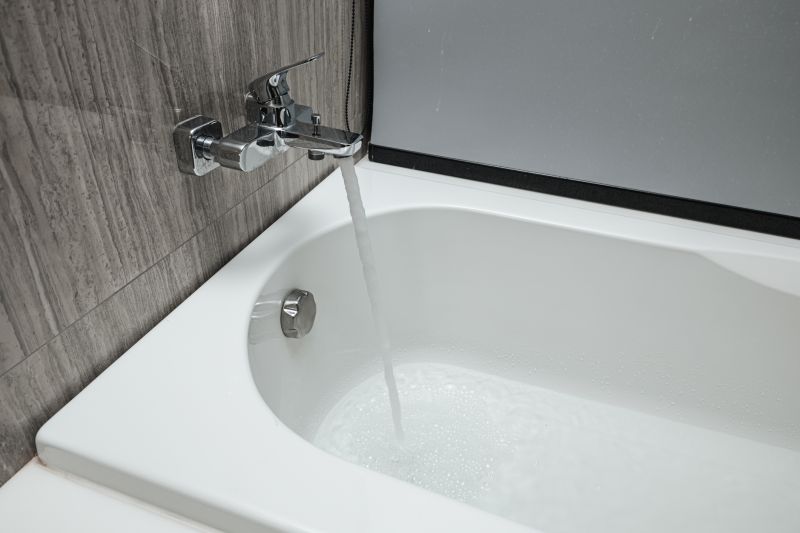Favorite Bathtub Refinishings Supplies For Easy DIY Renovations
Get the essential tools and materials trusted by homeowners for simple, effective bathtub refinishing projects.
 Bathtub refinishing is a practical solution for revitalizing worn or outdated tubs without the need for full replacement. This process typically involves cleaning the existing surface thoroughly, repairing any chips or cracks, and applying a specialized coating or resurfacing product that adheres to the original material. The goal is to achieve a smooth, durable, and visually appealing finish that can extend the life of the bathtub and enhance the overall bathroom aesthetic.
Bathtub refinishing is a practical solution for revitalizing worn or outdated tubs without the need for full replacement. This process typically involves cleaning the existing surface thoroughly, repairing any chips or cracks, and applying a specialized coating or resurfacing product that adheres to the original material. The goal is to achieve a smooth, durable, and visually appealing finish that can extend the life of the bathtub and enhance the overall bathroom aesthetic.
Top Overall Option
Comprehensive Bathtub Refinishing Kit
A complete refinishing kit typically includes primers, bonding agents, topcoats, and repair tools, making it suitable for DIY enthusiasts seeking a streamlined process. These kits are designed to work with various surface types and often feature detailed instructions to help achieve a smooth, durable finish. They are a versatile choice for homeowners aiming to refresh their bathtub's appearance with minimal hassle.
Types of Products For Bathtub Refinishings
Epoxy Coatings
Epoxy-based coatings are known for their strong adhesion and chemical resistance, providing a durable surface suitable for high-use bathtubs.
Acrylic Enamel Paints
Acrylic enamel paints offer a smooth, glossy finish and are easy to apply, making them popular for DIY refinishing projects.
Polyurethane Topcoats
Polyurethane coatings provide a hard, protective layer that resists scratches and stains, enhancing durability.
Resurfacing Sprays
Spray-on resurfacing products allow for quick application and even coverage, suitable for smaller repairs or touch-ups.
Repair Fillers
Specialized fillers help fix chips, cracks, and imperfections before applying the final coating.
Bonding Primers
Primers improve adhesion of the topcoat to existing surfaces, ensuring a long-lasting finish.
Acid Wash Cleaners
These cleaners prepare the surface by removing soap scum, mineral deposits, and residues that can hinder adhesion.
Non-slip Coatings
Add safety features with coatings designed to provide a textured, slip-resistant surface.
Sealants and Topcoats
Sealants protect the refinished surface from moisture and stains, maintaining its appearance over time.
Textured Finishes
Products offering textured finishes can help hide imperfections and add a unique aesthetic.
UV Resistant Coatings
These coatings resist UV damage, helping to preserve the finish in areas exposed to sunlight.
High-Gloss Finishes
Glossy finishes enhance the visual appeal and make cleaning easier due to their smooth surface.
Matte Finishes
Matte coatings provide a subdued, non-reflective surface that can complement various bathroom styles.
Anti-Mold Coatings
Special formulations help inhibit mold and mildew growth, maintaining a clean appearance.
Heat-Resistant Coatings
Designed to withstand high temperatures, these coatings are ideal for bathtubs used with hot water.
Popular Choices
Widely used for their durability and adhesion qualities, epoxy coatings are favored in many refinishing projects.
Known for ease of application and glossy finish, acrylic paints are popular among DIY homeowners.
Convenient for quick touch-ups and small repairs, spray-on products are trending for their simplicity.
Essential for addressing surface imperfections before final coating application.
Primers that enhance adhesion are commonly used to improve the longevity of refinished surfaces.
Popular for protecting the refinished surface and maintaining its appearance.
Increasing safety with textured, slip-resistant coatings is a trending choice.
Favored for their shiny, easy-to-clean surfaces that enhance bathroom aesthetics.
Offering a modern look with non-reflective surfaces, matte finishes are increasingly popular.
Choosing UV resistant options can help preserve the finish in sunlit bathrooms.
Choosing the right products for bathtub refinishing can significantly impact the longevity and appearance of the finished surface. Many products are designed to work with various materials, including porcelain, fiberglass, acrylic, and cast iron. Surface preparation is crucial, and selecting compatible primers and bonding agents can improve adhesion and durability. It is also important to consider the ease of application, drying time, and safety precautions associated with each product.
Different refinishing products offer a range of finishes, from glossy and semi-gloss to matte textures. Some coatings are formulated to resist stains, scratches, and moisture, helping maintain their appearance over time. Proper application techniques, such as brushing, rolling, or spraying, contribute to achieving a seamless and professional-looking result. Regular maintenance and gentle cleaning will help preserve the refinished surface for years to come.
In addition to paints and coatings, repair kits and prep products are available to address surface imperfections before applying the final finish. These kits often include fillers, sanding blocks, and cleaning solutions tailored for bathtub surfaces. When selecting products, consider your specific needs, the existing material of your bathtub, and the desired final look to ensure a successful refinishing project.
Key Buying Considerations
- Compatibility with your existing bathtub material such as porcelain, fiberglass, or acrylic.
- Type of finish desired, whether glossy, matte, or textured.
- Durability and resistance to scratches, stains, and moisture over time.
- Ease of application, especially if opting for DIY projects.
- Drying and curing times to plan your project schedule accordingly.
- Surface preparation requirements, including cleaning and repairing prior to coating.
- Compatibility of primers and bonding agents with the topcoat for optimal adhesion.
- Safety precautions, including ventilation needs and handling instructions.
- Resistance to mold and mildew if applicable to your bathroom environment.
- Availability of repair kits for addressing surface imperfections before refinishing.
- Environmental conditions during application, such as humidity and temperature.
- Long-term maintenance and cleaning recommendations to preserve the finish.
- Cost considerations, balancing quality and budget constraints.
- Customer reviews and ratings to gauge product performance and user satisfaction.
- Manufacturer instructions and technical support availability.
